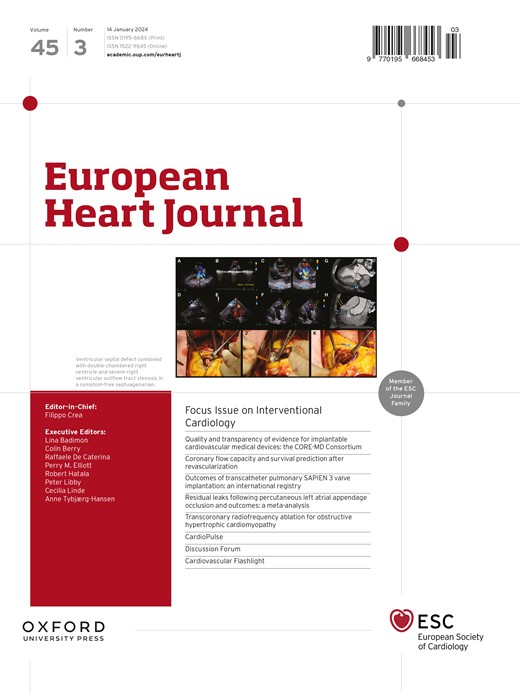LDL-cholesterol, lipoprotein(a) and high-sensitivity low-density lipoprotein cholesterol, lipoprotein(a) and high-sensitivity C-reactive protein are independent predictors of cardiovascular events
IF 37.6
1区 医学
Q1 CARDIAC & CARDIOVASCULAR SYSTEMS
引用次数: 0
Abstract
Background and Aims Associations of hyperlipidaemia and inflammation with the risk for incident major adverse cardiovascular events (MACEs) were analysed in individuals with and without cholesterol-lowering medication therapy. Methods Data from 322,922 participants (55.9% women) aged 38 to 73 years from the UK Biobank were included. Longitudinal associations of low-density lipoprotein cholesterol (LDL-C), lipoprotein(a) [Lp(a)], and high-sensitivity C-reactive protein (Hs-CRP), both individually and in combination, were analysed with the risk for incident MACEs using Cox regression models, stratified by cholesterol-lowering medication use. Results During a median follow-up of 13.7 years, 31,295 (9.69%) participants had incident MACEs. The incidence was 8.32% in non-users and 18.6% in users of cholesterol-lowering medication. Higher LDL-C levels were associated with the highest risk for MACEs, followed by Lp(a) and Hs-CRP. One higher standard deviation in LDL-C, Lp(a), and Hs-CRP was associated with a 13%, 8%, and 6% greater risk for MACEs in non-users and 11%, 7%, and 6% in cholesterol-lowering medication users, respectively. When combined, LDL-C, Lp(a), and Hs-CRP demonstrated a synergistic effect. Compared with individuals with all three biomarkers at or below the 75th percentile, those with all three biomarkers above the 75th percentile had a 77% higher risk for incident MACEs among non-users and a 58% higher risk among those on cholesterol-lowering medications. Conclusions Hyperlipidaemia and inflammation independently and synergistically contribute to an increased risk for incident cardiovascular events. The magnitude of risk is more closely related to serum biomarker concentrations than to the use or not of cholesterol-lowering medications.低密度脂蛋白胆固醇、脂蛋白(a)和高敏低密度脂蛋白胆固醇、脂蛋白(a)和高敏c反应蛋白是心血管事件的独立预测因子
背景和目的在接受和不接受降胆固醇药物治疗的个体中分析高脂血症和炎症与主要不良心血管事件(mace)发生风险的关系。方法纳入来自英国生物银行(UK Biobank)年龄38 - 73岁的322,922名参与者(55.9%为女性)的数据。低密度脂蛋白胆固醇(LDL-C)、脂蛋白(a) [Lp(a)]和高敏c反应蛋白(Hs-CRP)的纵向关联,无论是单独的还是联合的,使用Cox回归模型分析了mace事件的风险,并按降胆固醇药物的使用分层。结果在13.7年的中位随访期间,31295名(9.69%)参与者发生mace事件。未使用降胆固醇药物者的发病率为8.32%,使用降胆固醇药物者的发病率为18.6%。较高的LDL-C水平与mace的最高风险相关,其次是Lp(a)和Hs-CRP。LDL-C、Lp(a)和Hs-CRP的标准偏差越高,非使用降胆固醇药物者发生mace的风险分别增加13%、8%和6%,使用降胆固醇药物者发生mace的风险分别增加11%、7%和6%。LDL-C、Lp(a)和Hs-CRP联合使用时表现出协同作用。与所有三种生物标志物均处于或低于第75百分位的个体相比,所有三种生物标志物均高于第75百分位的个体在非使用者中发生MACEs的风险高出77%,在服用降胆固醇药物的人群中风险高出58%。结论:高脂血症和炎症可单独或协同增加心血管事件发生的风险。风险的大小与血清生物标志物浓度的关系比与是否使用降胆固醇药物的关系更密切。
本文章由计算机程序翻译,如有差异,请以英文原文为准。
求助全文
约1分钟内获得全文
求助全文
来源期刊

European Heart Journal
医学-心血管系统
CiteScore
39.30
自引率
6.90%
发文量
3942
审稿时长
1 months
期刊介绍:
The European Heart Journal is a renowned international journal that focuses on cardiovascular medicine. It is published weekly and is the official journal of the European Society of Cardiology. This peer-reviewed journal is committed to publishing high-quality clinical and scientific material pertaining to all aspects of cardiovascular medicine. It covers a diverse range of topics including research findings, technical evaluations, and reviews. Moreover, the journal serves as a platform for the exchange of information and discussions on various aspects of cardiovascular medicine, including educational matters.
In addition to original papers on cardiovascular medicine and surgery, the European Heart Journal also presents reviews, clinical perspectives, ESC Guidelines, and editorial articles that highlight recent advancements in cardiology. Additionally, the journal actively encourages readers to share their thoughts and opinions through correspondence.
 求助内容:
求助内容: 应助结果提醒方式:
应助结果提醒方式:


